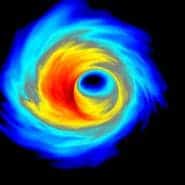Black Holes are the least understood entities, so far, in the Universe. However, if there’s one thing scientists know for sure about them, it’s that they’re the most extreme environment in cosmos. Black Holes have such a powerful, relentless gravity pull that it swallows absolutely everything in its vicinity, even light gets absorbed with zero reflection. This makes it practically invisible, which is why they’re very difficult to study. Scientists are now set to embark on one of the most ambitious astrophysical ventures in history – taking a picture of a black hole. No, by no means is this a mad science stunt. The greatest minds of the scientific community have pledged their aid for the project and firmly believe this is possible, in an unprecedented worldwide combined effort, which only a few years ago would’ve been considered ludicrous.
“Nobody has ever taken a picture of a black hole,” said Dimitrios Psaltis, an associate professor of astrophysics at the University of Arizona’s Steward Observatory, who along with Daniel Marrone, an assistant professor of astronomy at Steward Observatory, organized a conference in Tucson, Ariz. where the endeavor was announced “We are going to do just that.”
“Even five years ago, such a proposal would not have seemed credible,” added Sheperd Doeleman, assistant director of the Haystack Observatory at Massachusetts Institute of Technology (MIT), who is the principal investigator of the Event Horizon Telescope, as the project is dubbed. “Now we have the technological means to take a stab at it.”

Einstein’s Theory of Relativity laid the foundation for the postulation of black holes, proving gravity does indeed influence light’s motion. Based on Einstein’s theory, fellow German physicist Karl Schwarzschild found a solution which described the gravitational field of a point mass and a spherical mass. Since then, scientists have observed, measured and conducted experiments for decades with significant breakthroughs, however it was never possible for them to directly observe or image a black hole. But if black holes don’t emit light, how is it possible to image them? Professor Doeleman explains this extremely ingenious project in a masterful way.
“As dust and gas swirls around the black hole before it is drawn inside, a kind of cosmic traffic jam ensues,” Doeleman explained. “Swirling around the black hole like water circling the drain in a bathtub, the matter compresses and the resulting friction turns it into plasma heated to a billion degrees or more, causing it to ‘glow’ – and radiate energy that we can detect here on Earth.”
Capturing the Milky Way’s supermassive black hole halo
Very clever, right? Once light passes the point of no return, or Event Horizon, it is lost forever, however its outline can be studied – this is called the black hole’s shadow.
Scientists have well founded reasons to believe that at the center of the Milky Way, like in most galaxies, if not all actually, lies a supermassive black hole (one to four million times the mass of the sun). Estimated at 26,000 light years away, to have a chance at seeing it scientists say you’d need a very big telescope – a telescope the size of the entire Earth to be more exact.
Of course, there’s a solution around this – connecting the biggest and most powerful radio telescopes in the world together. As such, 50 radio telescopes scattered around the globe have joined the effort, including the Submillimeter Telescope (SMT) on Mt. Graham in Arizona, telescopes on Mauna Kea in Hawaii and the Combined Array for Research in Millimeter-wave Astronomy (CARMA) in California. The astronomers hope once the biggest telescope in the world, the Atacama Large Millimeter Array (ALMA) in Chile, is finished it will provide the necessary power to provide the project, the Event Horizon Telescope as it was dubbed, with a great chance of success.
“In essence, we are making a virtual telescope with a mirror that is as big as the Earth,” Doeleman said. “Each radio telescope we use can be thought of as a small silvered portion of a large mirror. With enough such silvered spots, one can start to make an image.”
“The Event Horizon Telescope is not a first-light project, where we flip a switch and go from no data to a lot of data,” he added. “Every year, we increase its capabilities by adding more telescopes, gradually sharpening the image we see of the black hole.”
General Relativity predicts that the bright outline defining the black hole’s shadow must be a perfect circle. If this shape will be found to be deviated in any manner, than it would prove that the Theory of Relativity is wrong. On the contrary, if it is indeed a circle, little doubt would be left to cast.
Bringing together radio telescopes around the globe requires an extraordinary global team effort, and I can only salute this initiative. What a milestone for science would it be if the researchers will manage to capture a black hole’s shadow.
“This is not only the usual international conference where people come from all over the world because they are interested in sharing their research,” Psaltis said. “For the Event Horizon Telescope, we need the entire world to come together to build this instrument because it is as big as the planet. People are coming from all over the world because they have to work on it.”






